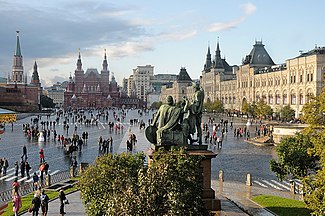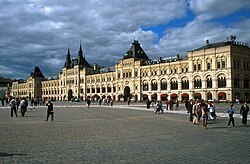




















GUM Christmas Market on Red Square
Wiki Notes:
GUM (department store)
From Wikipedia, the free encyclopedia
GUM (Russian: ГУМ, pronounced [ˈɡum], an abbreviation of the Russian: Глáвный универсáльный магазѝн; Glávnyj Universáĺnyj Magazín; literally "main universal store") is the name of the main department store in many cities of the former Soviet Union, known as State Department Store (Russian: Государственный универсальный магазин; Gosudarstvennyi Universalnyi Magazin) during the Soviet times. Similarly named stores were found in some Soviet republics and post-Soviet states. The most famous GUM is the large store in the Kitai-gorod part of Moscow facing Red Square. It is currently a shopping mall. Prior to the 1920s, the location was known as the Upper Trading Rows (Russian: Верхние торговые ряды). Nearby, also facing Red Square, is a building very similar to GUM, known formerly as the Middle Trading Rows, now the Central Universal Department Store (Russian: Центрáльный Универсáльный Магазѝн (ЦУМ) / Centráĺnyj Universáĺnyj Magazín (CUM)). It is about the same size as a large North American shopping mall. It has a clear roof.
Red Square
From Wikipedia, the free encyclopedia
| The Kremlin and Red Square, Moscow | |
|---|---|

View of Red Square looking northwest from St. Basil's Cathedral
|
IPA: [ˈkrasnəjə ˈploɕːətʲ]) is a city square (plaza) in Moscow, Russia. It separates the Kremlin, the former royal citadel and currently the official residence of the President of Russia, from a historic merchant quarter known as Kitai-gorod. Red Square is often considered the central square of Moscow since Moscow's major streets, which connect to Russia's major highways, originate from the square.
The name Red Square does not originate from the pigment of the surrounding bricks (which, in fact, were whitewashed at certain periods) nor from the link between the color red and communism. Rather, the name came about because the Russian word красная (krasnaya), which means "red," was applied to a small area between St. Basil's Cathedral, the Spassky Tower of the Kremlin, and the Lobnoe Mesto, and Tsar Alexei Mikhailovich officially extended the name to the entire square. Several ancient Russian towns, such as Suzdal, Yelets, and Pereslavl-Zalessky, have their main square named Krasnaya ploshchad.
The rich history of Red Square is reflected in many paintings by Vasily Surikov, Konstantin Yuon and others. The square was meant to serve as Moscow's main marketplace. It was also the site of various public ceremonies and proclamations, and occasionally a coronation for Russia's Tsars would take place. The square has been gradually built up since that point and has been used for official ceremonies by all Russian governments since it was established.




